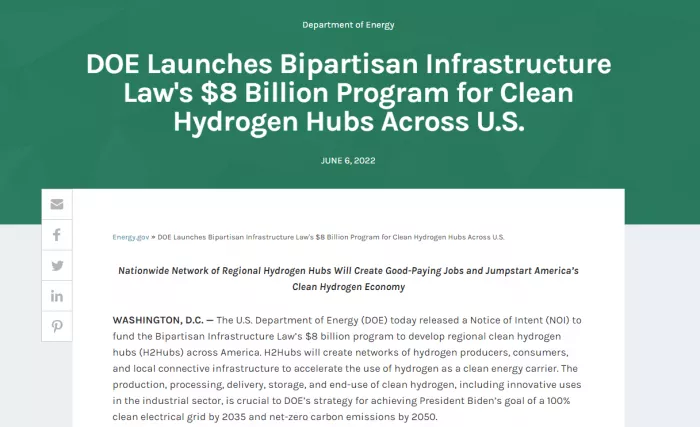According to the verge report, the US Department of energy [launched] on Monday( https://www.energy.gov/articles/doe-launches-bipartisan-infrastructure-laws-8-billion-program-clean-hydrogen-hubs-across ) A new $8billion program was launched to develop a central network for the production of hydrogen as a clean fuel** This is a milestone for one of the Biden administration's most controversial strategies to address climate change.

Hydrogen has the potential to cut emissions from some of the most difficult industries to clean up. It could replace coal used to make steel or fossil fuels used to power diesel trucks and cargo ships. When burned, it produces water vapor rather than greenhouse gas emissions (although it still causes nitrogen oxide pollution in the air).
The tricky thing is that not all hydrogen is produced in the same way, and there may be different benefits and pitfalls. At present, most hydrogen is produced from gas. In order to produce hydrogen from gas, methane reacts with high-temperature steam under high pressure. This process releases carbon dioxide, and then there is the threat of methane leakage from the entire natural gas industry to the climate. Methane is a more powerful greenhouse gas than carbon dioxide.
Therefore, the Biden government needs to clean up hydrogen production before using hydrogen to decarbonize other industries. On Monday, the US Department of energy proposed some plans to clean up the process. It submitted a notice of intent (NOI), which said that it planned to announce a funding opportunity in September or October to develop a clean hydrogen center, which it called "h2hubs".
The bipartisan infrastructure Act provides funding for at least four centers; Noi noted that the US Department of energy is considering funding six to ten centers to launch its program. At least one of these centers should use renewable energy to produce hydrogen. Another center should be to use nuclear energy to power hydrogen production. Moreover, at least one center should be able to prove that it can produce clean hydrogen from fossil fuels by matching the technology of capturing and storing carbon dioxide emissions. However, the US Department of energy also said that it would look for at least two centers in areas with "rich natural gas resources", which may lead to more h2hubs operating on fossil fuels rather than renewable energy.
Clean energy experts are paying close attention to the Department of energy's actions on hydrogen. Hydrogen production by pairing gas with carbon capture does not create a truly clean fuel, and may even lead to more greenhouse gas emissions in some cases. In a study published last year, researchers from Stanford University and Cornell University found that when this kind of hydrogen is used to heat buildings, it may be less environmentally friendly than the heating system it replaces. This is mainly because the production and use of natural gas is full of methane leakage from oil wells, pipelines, and even household and enterprise electrical appliances. This is a huge climate issue that may extend to natural gas based hydrogen centers.
Experts from the nonprofit union of concerned scientists and RMI said that due to this risk, the U.S. Department of energy needs to tighten its standards on what is a clean hydrogen project. Its $8billion clean hydrogen fund comes from the bipartisan infrastructure law passed last year, and the language in the law only considers the impact of carbon dioxide emissions from hydrogen production sites on the climate.
Non profit organizations believe that a safer approach is to carefully review all greenhouse gas emissions from the entire supply chain and hydrogen production process. The noi released this week shows that the Department of energy may keep this in mind when evaluating fund applications. The Department "intends to evaluate the full life cycle emissions of each application and will give priority to applications to reduce greenhouse gas emissions throughout the life cycle of the project".
In contrast, the real "green hydrogen" is produced by renewable energy driven electrolysis, which decomposes water to obtain hydrogen. This process is less polluting, but it is still more expensive than making hydrogen from gas and carbon capture because of the high cost of electrolyzers.
The Biden administration is trying to reduce this cost. The US president on Monday authorized the use of the defense production act to strengthen the domestic supply chain of clean energy technologies, including electrolyzers. The US Department of energy launched a plan last year to reduce the cost of clean hydrogen by 80% to US $1 per kilogram by the end of this century.